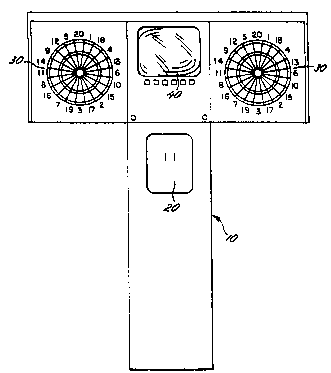Some of the information on this Web page has been provided by external sources. The Government of Canada is not responsible for the accuracy, reliability or currency of the information supplied by external sources. Users wishing to rely upon this information should consult directly with the source of the information. Content provided by external sources is not subject to official languages, privacy and accessibility requirements.
Any discrepancies in the text and image of the Claims and Abstract are due to differing posting times. Text of the Claims and Abstract are posted:
| (12) Patent Application: | (11) CA 2054204 |
|---|---|
| (54) English Title: | MULTIPLE TARGET ELECTRONIC DART GAME |
| (54) French Title: | JEU DE DARDS ELECTRONIQUE A CIBLES MULTIPLES |
| Status: | Deemed Abandoned and Beyond the Period of Reinstatement - Pending Response to Notice of Disregarded Communication |
| (51) International Patent Classification (IPC): |
|
|---|---|
| (72) Inventors : |
|
| (73) Owners : |
|
| (71) Applicants : | |
| (74) Agent: | CASSAN MACLEAN |
| (74) Associate agent: | |
| (45) Issued: | |
| (86) PCT Filing Date: | 1991-03-20 |
| (87) Open to Public Inspection: | 1991-10-31 |
| Examination requested: | 1998-01-20 |
| Availability of licence: | N/A |
| Dedicated to the Public: | N/A |
| (25) Language of filing: | English |
| Patent Cooperation Treaty (PCT): | Yes |
|---|---|
| (86) PCT Filing Number: | PCT/US1991/001873 |
| (87) International Publication Number: | WO 1991016593 |
| (85) National Entry: | 1991-12-02 |
| (30) Application Priority Data: | ||||||
|---|---|---|---|---|---|---|
|
2054204 9116593 PCTABS00008
A multiple target electronic dart game having shared
microprocessor means (50) that monitors and services operation of the
electronic dart game. The multiple targets (30) are mounted on opposite
sides of a column (10) which may be floor-standing or wall
mountable. Affixed to the top of the column is visual display means
(40) for providing players and observers with game scores and the
like. The visual display means is optionally capable of
split-screen presentation. The novel design of the multiple target
electronic dart game enables players to play dart games not previously
available with single target dart games. Moreover, many components
utilized by the controls are shared, thus enabling cost savings by
eliminating substantial duplication of components.
Note: Claims are shown in the official language in which they were submitted.
Note: Descriptions are shown in the official language in which they were submitted.

2024-08-01:As part of the Next Generation Patents (NGP) transition, the Canadian Patents Database (CPD) now contains a more detailed Event History, which replicates the Event Log of our new back-office solution.
Please note that "Inactive:" events refers to events no longer in use in our new back-office solution.
For a clearer understanding of the status of the application/patent presented on this page, the site Disclaimer , as well as the definitions for Patent , Event History , Maintenance Fee and Payment History should be consulted.
| Description | Date |
|---|---|
| Time Limit for Reversal Expired | 2002-03-20 |
| Application Not Reinstated by Deadline | 2002-03-20 |
| Deemed Abandoned - Failure to Respond to Maintenance Fee Notice | 2001-03-20 |
| Deemed Abandoned - Conditions for Grant Determined Not Compliant | 2001-03-13 |
| Notice of Allowance is Issued | 2000-09-13 |
| Letter Sent | 2000-09-13 |
| Notice of Allowance is Issued | 2000-09-13 |
| Inactive: Approved for allowance (AFA) | 2000-08-31 |
| Amendment Received - Voluntary Amendment | 2000-07-27 |
| Inactive: S.30(2) Rules - Examiner requisition | 2000-06-08 |
| Inactive: Application prosecuted on TS as of Log entry date | 1998-03-02 |
| Inactive: RFE acknowledged - Prior art enquiry | 1998-03-02 |
| Inactive: Status info is complete as of Log entry date | 1998-03-02 |
| All Requirements for Examination Determined Compliant | 1998-01-20 |
| Request for Examination Requirements Determined Compliant | 1998-01-20 |
| Application Published (Open to Public Inspection) | 1991-10-31 |
| Abandonment Date | Reason | Reinstatement Date |
|---|---|---|
| 2001-03-20 | ||
| 2001-03-13 |
The last payment was received on
Note : If the full payment has not been received on or before the date indicated, a further fee may be required which may be one of the following
Please refer to the CIPO Patent Fees web page to see all current fee amounts.
| Fee Type | Anniversary Year | Due Date | Paid Date |
|---|---|---|---|
| Request for examination - standard | 1998-01-20 | ||
| MF (application, 7th anniv.) - standard | 07 | 1998-03-20 | 1998-03-05 |
| MF (application, 8th anniv.) - standard | 08 | 1999-03-22 | 1999-01-19 |
| MF (application, 9th anniv.) - standard | 09 | 2000-03-20 | 2000-03-17 |
| MF (application, 2nd anniv.) - standard | 02 | 1993-03-22 |
Note: Records showing the ownership history in alphabetical order.
| Current Owners on Record |
|---|
| ARACHNID, INC. |
| Past Owners on Record |
|---|
| JOHN R. MARTIN |